Best Electric Car for Taxi Drivers: A Complete Guide

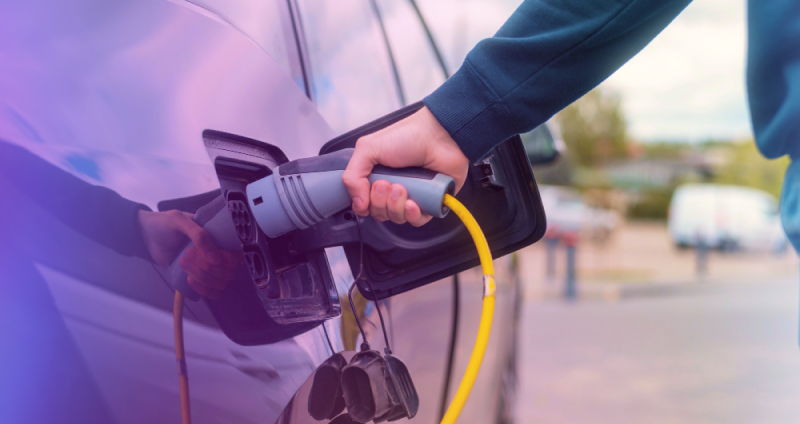
Electric taxis are no longer an experiment. In London you can already wave down one of more than six thousand EV cabs. In Oslo, the government set a clear date: by 2027 every new taxi must be electric. For a driver starting a shift at 6 a.m., that means the old rule of “fill up before work” is turning into “charge overnight and get moving.”
The best electric cars for taxi drivers are not always the flashiest models. Some rely on a Nissan Leaf for short city hops, others prefer the Hyundai Kona EV that lasts through an evening rush. Drivers who switched from petrol cars say the difference shows in their wallets first: fuel and service bills often drop by three to four thousand dollars a year. Add in fewer breakdowns, and there is more time on the road making money.
Passengers notice the change as well. Quieter engines, no exhaust smell, smoother rides. A late-night airport run feels different in an electric taxi, and ratings usually reflect that. Fleets that invest in the best electric taxi models also gain a reputation as cleaner and more modern. With platforms like Mobion Tech, managers can track vehicles, plan charging slots, and keep cars working without wasting hours.
Tesla Model 3
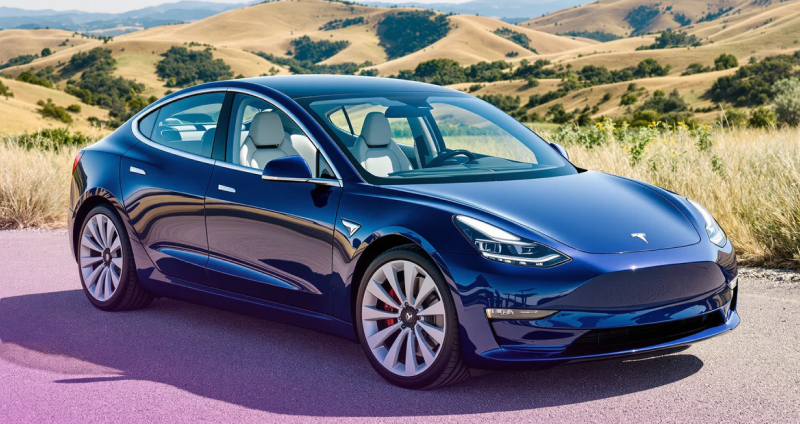
Talk to drivers who have tried an electric vehicle taxi and the Tesla Model 3 comes up almost every time. Some rely on the shorter-range model, good for a day of city rides. Others go for the longer battery option that lasts through airport runs, late-night shifts, and the odd out-of-town call. One London driver joked that he finishes his day before the battery does.
Charging is not the headache many expect. Half an hour at a Supercharger usually takes the battery from low to ready again. For a driver, that is the same as a quick lunch break. Routine servicing is lighter too. No oil checks, fewer brake jobs thanks to regenerative braking, and none of the exhaust repairs that come with gas engines. Drivers often mention saving a few thousand dollars a year just because those bills vanish.
Riders notice other things. The cabin is quiet, the pull at traffic lights is smooth, and there is no fuel smell on long trips. Many leave higher ratings simply because the journey feels better. The price tag is higher than a Leaf or Kona, but for fleets the math often works out. Less downtime, happier customers, and a modern image — that is why the Model 3 keeps showing up in taxi ranks across major cities.
Key Features
- Two range options for city or long shifts
- Quick top-ups at Tesla Superchargers
- Reduced servicing thanks to regenerative braking
- Quiet ride and positive passenger feedback
- Yearly savings compared with petrol cars
Volkswagen ID.4
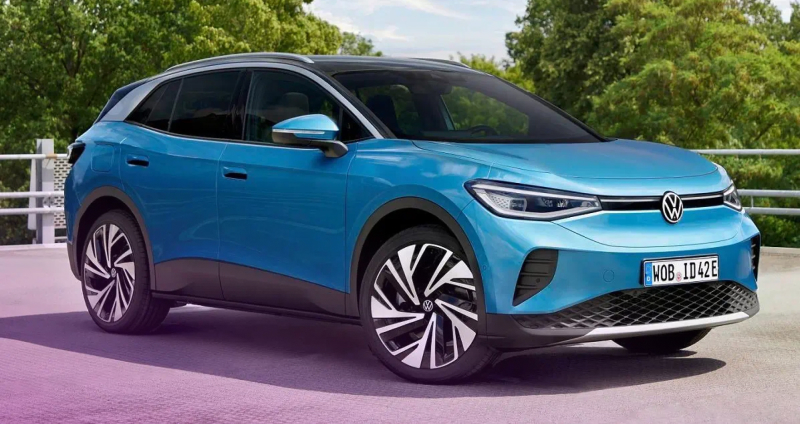
For many taxi operators, space and comfort are not extras - they are essentials. The Volkswagen ID.4 delivers both. Passengers notice the wider cabin and the ability to fit luggage without a struggle. Drivers see something else: a vehicle that feels closer to a traditional SUV while keeping operating costs low. In other words, it bridges the gap between practicality and efficiency. That makes it a serious option for fleets considering an electric car for taxi.
Range is described as enough for a full day’s work, even with a mix of city and suburban trips. You are unlikely to see drivers calculating every mile - they just want to finish a shift without worrying about the battery. Fast charging makes this easier. Around half an hour at a high-power station is usually all it takes, often lining up neatly with a meal break. Add in steady handling, good visibility, and reduced servicing needs, and the ID.4 starts to feel less like an experiment and more like a dependable fleet vehicle.
Key Features
- Practical range that supports daily shifts
- Spacious interior with SUV-level comfort
- Quick charging in about 30 minutes
- Reduced maintenance compared with petrol cars
- Positive passenger feedback across fleets
BYD e6
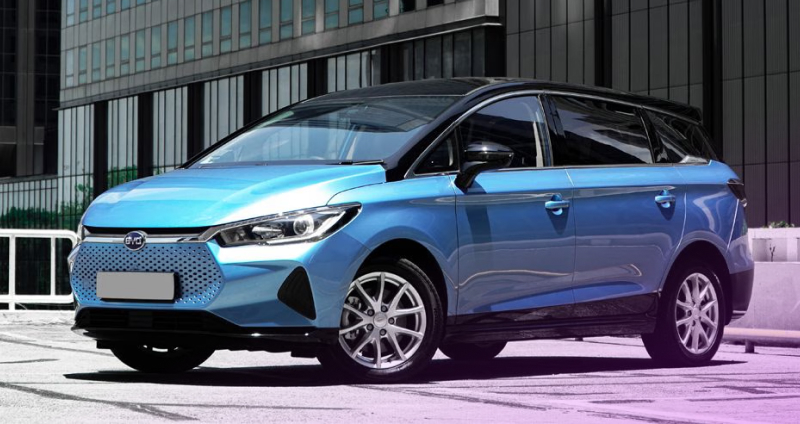
The BYD e6 has been a popular choice in Asian and European taxi markets for more than a decade. Its strength lies in durability. Fleets report that the car handles long daily use without major issues, which is why many operators see it as a dependable investment. A roomy cabin and flat floor design create extra space for passengers, making it practical for airport runs and city rides alike. For companies searching for a proven BYD electric taxi, this model often comes up first.
Battery capacity gives the e6 a range suitable for full shifts, and charging flexibility helps it fit into busy schedules. Fast charging can bring the battery back to workable levels in under an hour, which aligns with natural breaks in a driver’s routine. The ride itself is calm, with a focus on steady handling rather than speed. Combined with low maintenance requirements, the e6 continues to be one of the more cost-effective EVs for taxi fleets expanding into electric mobility.
Key Features
- Strong record of durability in taxi use
- Spacious cabin with flat floor design
- Range that covers daily shifts
- Fast charging available in under an hour
- Lower upkeep than comparable fuel cars
Kia Niro EV
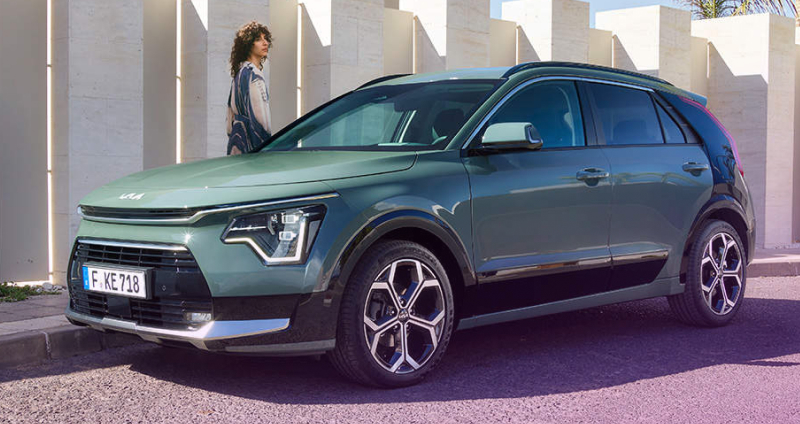
Fleet operators often look for a vehicle that works in the city but also feels comfortable on longer trips. The Kia Niro EV fits this profile well. It offers more space than a small hatchback yet stays easy to handle in crowded streets. Drivers mention that the ride feels stable and quiet, which helps during evening shifts when fatigue is an issue. For many companies, the Niro has become a practical choice when adding an electric car taxi to their lineup.
The range is enough for daily work without constant charging stops. When a top-up is needed, fast chargers usually restore most of the battery in under an hour, making it possible to recharge during a normal break. Passengers value the cabin comfort and the modern infotainment system, while fleet owners note that running costs remain well below petrol vehicles. That mix of usability, efficiency, and passenger approval explains why the Niro EV continues to gain ground in professional taxi services.
Key Features
- Practical range for city and suburban work
- SUV design with added passenger space
- Fast charging available in less than an hour
- Quiet ride suited for long shifts
- Reduced running costs for fleets
Polestar 2

Polestar 2 is often seen as a steady and practical choice for taxi fleets that want something modern but not oversized. The car offers a clean design, good visibility, and a cabin that feels simple to use during long shifts. For operators thinking about adding a taxi electric car, it delivers a mix of range and comfort that works for daily service.
The driving range is enough for full city shifts and occasional suburban rides. Charging from low to around 80 percent usually takes less than 40 minutes on a fast station, which fits into normal breaks. Drivers note that the handling feels solid, especially in heavy traffic. Passengers point out the quiet interior and comfortable seating. For fleet managers, lower fuel bills and reduced servicing needs make the Polestar 2 a cost-effective part of an EV lineup. It may not be the cheapest model, but the balance of efficiency and passenger approval keeps it relevant in competitive markets.
Key Features
- Range suitable for daily city work
- Fast charging in under 40 minutes
- Quiet cabin with comfortable seats
- Solid handling in urban traffic
- Lower operating costs than petrol cars
MG MG5

The MG MG5 is one of the few electric station wagons on the market, which makes it stand out for taxi fleets that need more luggage space without moving to a full SUV. Passengers benefit from the extended trunk, while drivers note that the car still handles city streets with ease. For companies looking at an electric taxi car that balances storage and efficiency, the MG5 often enters the discussion.
The range covers most daily shifts comfortably, and charging time is reasonable with fast-charging stations. Fleet managers pay attention to total running costs, and here the MG5 competes well with other models in its class. It is not the most premium EV, but its practical design gives it an advantage in airport transfers and family rides. To keep such vehicles organized and productive, operators often turn to tools like Mobion taxi service software, which helps manage routes, charging schedules, and overall fleet efficiency.
Key Features
- Station wagon design with extended trunk space
- Range that supports full-day taxi shifts
- Fast charging option for reduced downtime
- Practical handling in city and suburban routes
- Lower overall costs compared to petrol wagons
Renault Megane e-Tech
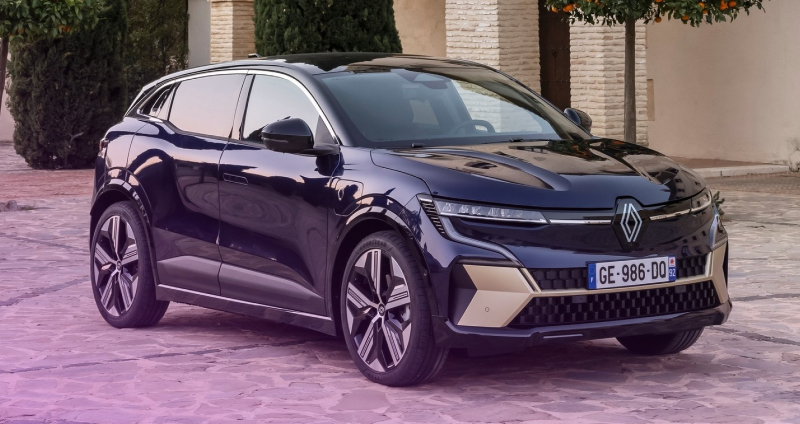
In busy cities, size matters. The Renault Megane e-Tech is compact enough to slip through traffic but still gives passengers a comfortable ride. Operators looking at electric cars for taxi often see it as a practical middle ground. Not too big. Not too small.
Range is built for daily work. Most shifts finish without the need for extra charging. When a top-up is needed, a fast station brings the battery back in less than an hour. Simple. Drivers like the clear controls and steady handling. Passengers talk more about the quiet cabin and the smooth feel on short trips. Costs stay low compared with fuel cars, and maintenance is lighter too. For many fleets, that is reason enough to keep the Megane in service.
Key Features
- Compact design for city driving
- Range that fits a full shift
- Fast charging under one hour
- Quiet ride, simple handling
- Lower running costs for fleets
Citroen ë-C4 X

The Citroen ë-C4 X sits between a sedan and an SUV. It gives drivers a roomy cabin and enough space for luggage, but it still feels compact in traffic. For operators choosing an electric car for taxi drivers, that mix of comfort and size is often the main reason to consider it.
The range is good enough for a day’s work. No need to plan around charging every few hours. A fast charger brings the battery back in under an hour, which matches a normal break. The suspension is soft, tuned more for comfort than speed. Passengers notice the quiet cabin. Drivers mention how simple the controls feel after a long shift. And fleet managers see the lower fuel and service bills compared with petrol cars.
Key Features
- Crossover design with extra cabin space
- Range that supports daily shifts
- Fast charging in under an hour
- Smooth suspension for city roads
- Reduced fuel and maintenance costs
Vauxhall Combo-e
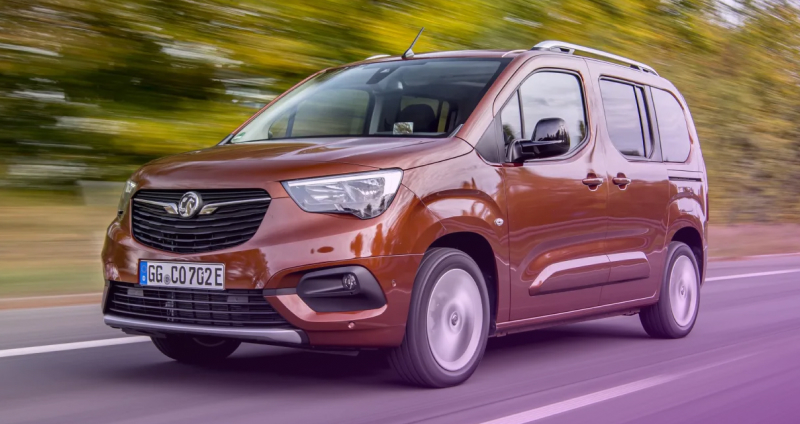
The Vauxhall Combo-e is not a typical choice for taxi fleets, but it fills a unique role. As a small van turned passenger vehicle, it gives much more headroom and luggage capacity than most EVs in its class. For companies that need space for groups or larger baggage, the Combo-e can be a practical ev taxi option.
Range is suited for short and medium routes. City work, school runs, and airport transfers are all possible on a single charge. When charging is needed, the battery reaches 80 percent in about 30 minutes with a fast charger. Drivers say the seating position feels closer to a van, giving good road visibility. Passengers notice the space more than the styling, and for many that comfort is the main value. Fleet managers highlight low service costs compared with fuel vans, which keeps operating budgets in check.
Key Features
- Extra headroom and luggage capacity
- Range suited for urban and suburban work
- Fast charging to 80% in ~30 minutes
- High driving position with good visibility
- Lower running costs than fuel vans
Nissan eNV-200
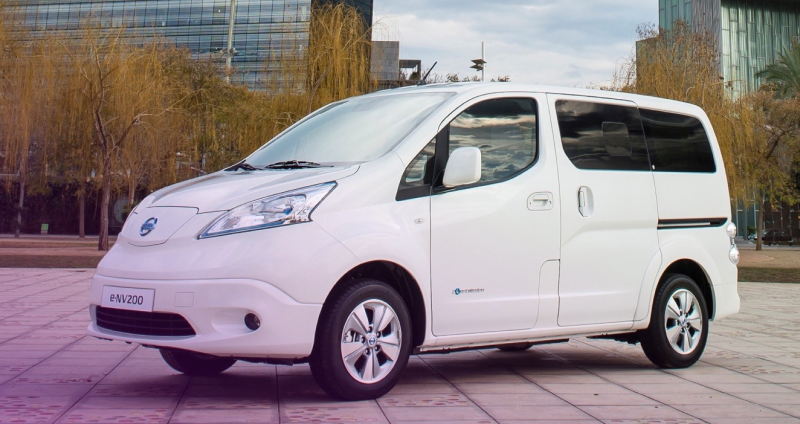
Many cities already use the Nissan eNV-200 as a taxi. It looks more like a compact van than a car, and that extra space makes a big difference. Passengers get wide seats, plenty of headroom, and sliding doors that are easy to handle in crowded streets. For fleets that need room for people and luggage, it has become a dependable nissan electric taxi.
The range covers a full day of city driving. Suburban trips are possible too without worrying about the battery. When charging is needed, fast stations bring it back to working levels during a normal driver break. No extra planning required. The higher seating position helps with visibility in traffic. Fleet owners note the steady savings compared with fuel vans, since service is lighter and running costs stay low. That combination of space, efficiency, and economy is why the eNV-200 continues to appear in taxi fleets across Europe.
Key Features
- Spacious cabin with easy access sliding doors
- Range that supports a full city shift
- Fast charging fits into regular breaks
- Higher driving position with good visibility
- Lower costs than fuel-powered vans
Final Thoughts
Range matters. Cost too. Space? Always. Different fleets, different needs. Need long trips? Tesla Model 3. Big luggage? Nissan eNV-200. Tight city streets? Renault Megane e-Tech or Peugeot e-208. There is no single best ev for taxi.
And that’s the point. The market for electric taxis is not one-size-fits-all. Each model has a role. Some win on comfort. Others on budget. A few on battery life. The table shows how they compare — side by side, without the guesswork.
| Model | Range (approx) | Strengths | Suitability Rating (1–5) |
|---|---|---|---|
| Tesla Model 3 | 272–333 miles | Long range, strong reliability | ⭐⭐⭐⭐⭐ |
| Nissan Leaf | ~150–220 miles | Affordable, easy city use | ⭐⭐⭐ |
| Volkswagen ID.4 | ~260 miles | Spacious SUV comfort | ⭐⭐⭐⭐ |
| BYD e6 | ~250 miles | Durable, proven in fleets | ⭐⭐⭐⭐ |
| Kia Niro EV | ~250 miles | Compact SUV balance | ⭐⭐⭐⭐ |
| Hyundai Kona EV | ~258 miles | Efficient, manageable size | ⭐⭐⭐⭐ |
| Polestar 2 | ~270 miles | Premium feel, solid handling | ⭐⭐⭐⭐ |
| MG MG5 | ~250 miles | Station wagon storage | ⭐⭐⭐ |
| Renault Megane e-Tech | ~250 miles | Compact city design | ⭐⭐⭐ |
| Peugeot e-208 | ~210 miles | Small, efficient for urban routes | ⭐⭐⭐ |
| Citroen ë-C4 X | ~220 miles | Comfortable crossover | ⭐⭐⭐⭐ |
| Vauxhall Combo-e | ~170 miles | Extra headroom and luggage space | ⭐⭐⭐ |
| Nissan eNV-200 | ~170 miles | Taxi van flexibility | ⭐⭐⭐⭐ |
What would your fleet choose?
For better control of any choice, request a demo of Request Mobion demo
F.A.Q.
Ready to revolutionize your taxi business?
Choose what you need: